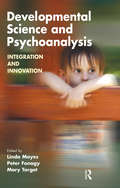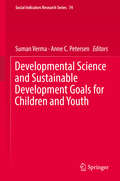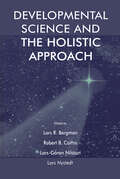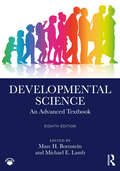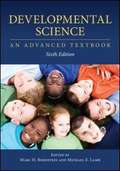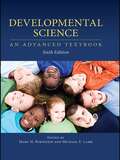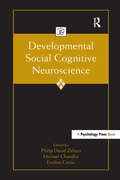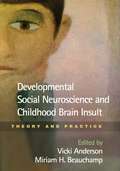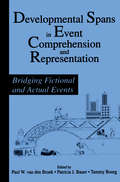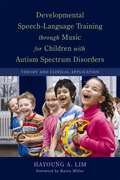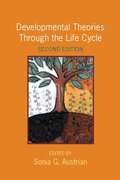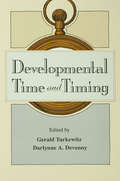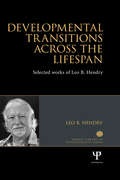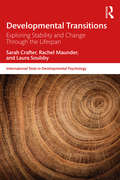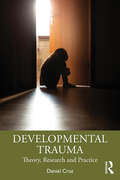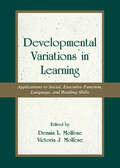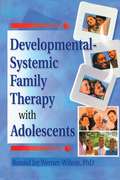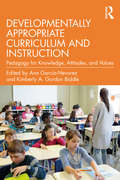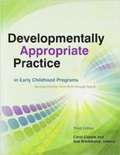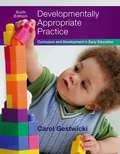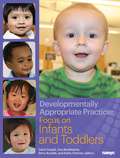- Table View
- List View
Developmental Science and Psychoanalysis: Integration and Innovation (The\developments In Psychoanalysis Ser.)
by Peter Fonagy Mary Target Linda MayesAs a discipline, psychoanalysis began at the interface of mind and brain and has always been about those most basic questions of biology and psychology: loving, hating, what brings us together as lovers, parents, and friends and what pulls us apart in conflict and hatred. These are the enduring mysteries of life and especially of early development-how young children learn the language of the social world with its intertwined biological, genetic, and experiential roots and how infants translate thousands of intimate moments with their parents into a genuine, intuitive, emotional connection to other persons. Basic developmental neuroscience and psychology has also of late turned to these basic questions of affiliation: of how it is that as humans our most basic concerns are about finding, establishing, preserving, and mourning our relationships. These areas in broad strokes are the substance of mind and brain, and the last decade has brought much new science to the biology of attachment, love, and aggression.
Developmental Science and Sustainable Development Goals for Children and Youth (Social Indicators Research Series #74)
by Anne C. Petersen Suman VermaThis book presents new scientific knowledge on using developmental science to improving lives of children and youth across the globe. It highlights emerging pathways to sustainability as well as the interconnectedness and interdependence of developmental science and sustainable children and youth development globally. Presenting cross-cultural views and current perspectives on the role of developmental science in the realization of the Sustainable Development Goals for children and youth development, contributors from different disciplines from low-and-middle-income countries or scholars working in these countries capture ground realities of the situation of children and youth in these regions. This book addresses developmental issues related to inequity, gender, health, education, social protection, and needs of vulnerable populations of children and youth. Other areas of focus are improving mechanisms and monitoring frameworks of development and well-being indicators.
Developmental Science and the Holistic Approach
by Lars-Goran Nilsson Lars R. Bergman Robert B. Cairns Lars NystedtThis book is the outcome of a symposium where leading researchers, mainly in developmental psychology, came together to discuss the implications of the emerging developmental science and the holistic approach. In doing this, the authors wanted to honor a distinguished colleague, David Magnusson, and his career-long contributions to this field. The purpose of the book is to discuss the profound implications for developmental science of the holistic paradigm, especially with regard to the individual development within psychology. Against the background of their own empirical, theoretical, or methodological research, the authors have tried to identify what is needed for the developmental theory and methods within this paradigm and discuss possibilities and limitations in relation to conventional approaches.
Developmental Science: An Advanced Textbook
by Marc H. Bornstein Michael E. LambDevelopmental Science: An Advanced Textbook is the most complete and cutting-edge introduction to the field available today. Since its initial publication, the key purpose of the text has been to furnish inclusive developmental perspectives on all substantive areas in psychology--neuroscience, perception, cognition, language, emotion, and social interaction. This edition is no exception, as it continues to underscore the dynamic and exciting status of contemporary developmental science. In this Seventh Edition, Marc H. Bornstein and Michael E. Lamb once again invite international experts to prepare original, comprehensive, and topical treatments of the major areas of developmental science, which are masterfully woven into a single coherent volume. Some chapters in this edition are new, and those carried forward from the sixth edition have been extensively revised. This volume represents faithfully the current status of scholarly efforts in all aspects of developmental science. Ideal for advanced undergraduate and introductory graduate courses, the text is accompanied by a website with supplementary material for students and instructors, including chapter outlines, topics to think about before reading, glossaries, and suggested readings.
Developmental Science: An Advanced Textbook
by Marc H. Bornstein Michael E. LambDevelopmental Science: An Advanced Textbook is the most complete and up-to-date advanced introduction to the field available today. Since its initial publication, the key purpose of this advanced textbook has been to furnish inclusive developmental perspectives on all theoretical, methodological, and substantive areas in developmental science. This eighth edition is no exception, as it continues to underscore the dynamic and exciting status of contemporary developmental science.In this eighth edition, Marc H. Bornstein and Michael E. Lamb have invited international experts to prepare original, comprehensive, and topical treatments of all major areas of developmental science; they are masterfully woven into a single coherent volume. The substantive chapters cover essentials of their main topics, with close attention paid to cultural, lifespan, and applied perspectives. Many chapters in this eighth edition are new, and those carried forward from the seventh edition have been extensively revised. This volume therefore represents faithfully the current status of scholarly efforts in all aspects of developmental science.Ideal for advanced undergraduate and introductory graduate courses, this advanced textbook is accompanied by two sets of supplementary materials: pedagogy files for students include chapter outlines, things to think about before reading the chapters, glossaries, and suggested readings; and ancillary files for instructors include a PowerPoint deck of tables and figures, classroom assignments, essay questions, multiple-choice questions, and short-answer questions.
Developmental Science: An Advanced Textbook,
by Marc H. Bornstein Michael E. LambNoted as one of the most comprehensive textbooks in the field, Developmental Science, 6th Edition introduces readers to all of areas in developmental psychology: neuroscience, genetics, perception, cognition, language, emotion, self, and social interaction. Each of the world-renowned contributors masterfully introduces the history and systems, methodologies, and measurement and analytic techniques used to understand the area of human development under review. The relevance of the field is illustrated through engaging applications in each chapter. As a whole, this highly-respected text illuminates substantive phenomena in developmental science, its applications across the life span, and its relevance to everyday life. Each chapter has been substantially revised for this new edition to reflect the current state of the field and the new edition is now accompanied by a website. Students and instructors will find chapter outlines, topics to think about before reading the chapters, a glossary, and suggested readings with active reference links on the website. Electronic access to the text's figures and tables, suggestions for classroom assignments and/or discussion, and a test bank with multiple-choice, short answer, and essay questions is limited to instructors only. Two new chapters highlight many modern developments. Each chapter features an introduction, up-to-date overviews of the field, summary and conclusion, and numerous classical and contemporary references. The book opens with an overview of developmental science -- its history and theory, the cultural orientation to thinking about human development, and the manner in which empirical research is designed, conducted, and analyzed. Part 2 focuses on the field's major substantive areas: neuroscience and genetics, physical and motor skills, perception, and cognitive and language development. Part 3 examines personality and social development within the context of the various relationships and situations in which developing individuals function and by which they are shaped. The book concludes with a new chapter on the latest applications of developmental science. Ways in which developmental thinking and research affect and are affected by practice and social policy are particularly emphasized. Used primarily as a graduate level text for courses on developmental psychology/science, life span, and/or human development, the book can also be used at the advanced undergraduate level. Researchers interested in staying abreast of the latest developments in the field also appreciate the book's comprehensive nature.
Developmental Science: An Advanced Textbook, Sixth Edition
by Marc H. Bornstein Michael E. LambNoted as one of the most comprehensive textbooks in the field, Developmental Science, 6th Edition introduces readers to all of areas in developmental psychology: neuroscience, genetics, perception, cognition, language, emotion, self, and social interaction. Each of the world-renowned contributors masterfully introduces the history and systems, methodologies, and measurement and analytic techniques used to understand the area of human development under review. The relevance of the field is illustrated through engaging applications in each chapter. As a whole, this highly-respected text illuminates substantive phenomena in developmental science, its applications across the life span, and its relevance to everyday life. Each chapter has been substantially revised for this new edition to reflect the current state of the field and the new edition is now accompanied by a website. Students and instructors will find chapter outlines, topics to think about before reading the chapters, a glossary, and suggested readings with active reference links on the website. Electronic access to the text's figures and tables, suggestions for classroom assignments and/or discussion, and a test bank with multiple-choice, short answer, and essay questions is limited to instructors only. Two new chapters highlight many modern developments. Each chapter features an introduction, up-to-date overviews of the field, summary and conclusion, and numerous classical and contemporary references. The book opens with an overview of developmental science -- its history and theory, the cultural orientation to thinking about human development, and the manner in which empirical research is designed, conducted, and analyzed. Part 2 focuses on the field's major substantive areas: neuroscience and genetics, physical and motor skills, perception, and cognitive and language development. Part 3 examines personality and social development within the context of the various relationships and situations in which developing individuals function and by which they are shaped. The book concludes with a new chapter on the latest applications of developmental science. Ways in which developmental thinking and research affect and are affected by practice and social policy are particularly emphasized. Used primarily as a graduate level text for courses on developmental psychology/science, life span, and/or human development, the book can also be used at the advanced undergraduate level. Researchers interested in staying abreast of the latest developments in the field also appreciate the book's comprehensive nature.
Developmental Social Cognitive Neuroscience (Jean Piaget Symposia Series)
by Philip David Zelazo Michael Chandler Eveline CroneThis volume in the JPS Series is intended to help crystallize the emergence of a new field, "Developmental Social Cognitive Neuroscience," aimed at elucidating the neural correlates of the development of socio-emotional experience and behavior. No one any longer doubts that infants are born with a biologically based head start in accomplishing their important life tasks––genetic resources, if you will, that are exploited differently in different contexts. Nevertheless, it is also true that socially relevant neural functions develop slowly during childhood and that this development is owed to complex interactions among genes, social and cultural environments, and children’s own behavior. A key challenge lies in finding appropriate ways of describing these complex interactions and the way in which they unfold in real developmental time. This is the challenge that motivates research in developmental social cognitive neuroscience. The chapters in this book highlight the latest and best research in this emerging field, and they cover a range of topics, including the typical and atypical development of imitation, impulsivity, novelty seeking, risk taking, self and social awareness, emotion regulation, moral reasoning, and executive function. Also addressed are the potential limitations of a neuroscientific approach to the development of social cognition. Intended for researchers and advanced students in neuroscience and developmental, cognitive, and social psychology, this book is appropriate for graduate seminars and upper-level undergraduate courses on social cognitive neuroscience, developmental neuroscience, social development, and cognitive development.
Developmental Social Neuroscience and Childhood Brain Insult
by Vicki Anderson Miriam H. BeauchampSynthesizing cutting-edge knowledge from multiple disciplines, this book explores the impact of acquired brain injury and developmental disabilities on children's emerging social skills. The editors present an innovative framework for understanding how brain processes interact with social development in both typically developing children and clinical populations. Key issues in assessment are addressed, including ways to measure both social function and brain function using developmentally sound tools. Balancing theoretical and clinical concerns, the book describes promising interventions for promoting children's adjustment and helping them participate more fully in the social world. Illustrations include six color plates.
Developmental Spans in Event Comprehension and Representation: Bridging Fictional and Actual Events
by Patricia J. Bauer Paul W. van den Broek Tammy BourgThis book is about building metaphorical bridges--all sorts of bridges. At the most basic level, it concerns the bridges that individuals build to understand the events that they experience--the bridges that connect the events in the mind's eye. At another level, it is about bridges that interconnect findings and theoretical frameworks concerning event comprehension and representation in different age groups, ranging from infancy to adulthood. Finally, it is about building bridges between researchers who share interests, yet may not ordinarily even be aware of each other's work. The success of the book will be measured in terms of the extent to which the contributors have been able to create a picture of the course of development across a wide span in chronological age, and across different types of events, from the fictional to the actual. The individuals whose work is represented in this book conduct their work in a shared environment--they all have an intellectual and scholarly interest in event comprehension and representation. These interests are manifest in the overlapping themes of their work. These include a focus on how people come to temporally integrate individual "snapshots" to form a coherent event that unfolds over time, to understand cause and effect, and to appreciate the role of the goal of events. Another overlapping theme involves the possibility of individual differences. These themes are apparent in work on the early development of representations of specific episodes and autobiographical memories, and comprehension of complex events such as stories involving multiple characters and emotions. The editors of this volume had two missions: * to create a development span by bringing together researchers working from infancy to adulthood, and * to create a bridge between individuals working from within the text comprehension perspective, within the naturalistic perspective, and with laboratory analogues to the naturalistic perspective. Their measure of success will be the extent to which they have been able to create a picture of the course of development across a wide span in chronological age, and across different types of events--from fictional to actual.
Developmental Speech-Language Training through Music for Children with Autism Spectrum Disorders
by Hayoung A. LimSpeech and language impairments are one of the most challenging features of Autism Spectrum Disorders (ASD). Children with ASD are also known to be particularly responsive to music. This book makes a valuable connection between the two traits to showcase music as an effective way of enhancing the speech and language skills of children with ASD. This is a comprehensive guide to Dr. Hayoung Lim's highly effective approach of using music in speech-language training for children ASD. Part I provides a sound theoretical foundation and employs the most up-to-date research, including the author's own extensive study, to validate the use of music in speech and language training for children with ASD. Part II analyzes the clinical implications of "Developmental Speech- Language Training through Music" (DSLM) protocols and explains in detail specific interventions that can be used with the approach. The practical application of DSLM to Applied Behavior Analysis (ABA) Verbal Behavior (VB) approaches is also explored. This is essential reading for music therapists, speech and language pathologists and other professionals working with children with autism, as well as researchers and academics in the field.
Developmental Tasks in Adolescence
by Klaus Hurrelmann Gudrun QuenzelThe topic of adolescent development in Europe is one which has received little academic attention in recent years. Developmental Tasks in Adolescence makes an exciting contribution to the field by applying socialisation theory to four major developmental tasks of life: Qualifying, Bonding, Consumption and Participation, arguing that if the tasks in these areas are mastered, then personal individuation and social integration can take place, a prerequisite for the formation of self-identity. In highly developed societies, adolescence encompasses a period of about 15 years on average. Puberty, or the transition from childhood, starts earlier and earlier, and the transition to adulthood is increasingly postponed. Developmental Tasks in Adolescence proposes that the way in which adolescents master the tasks of everyday life has become a pattern of orientation for the life stages which follow because of the new lifestyle requirements that are typical for modern democratic societies. Today, a life full of uncertainties and ambiguities is no longer limited to adolescence, but rather continues into adulthood. Hurrelmann and Quenzel's sociological approach is valuable reading for students and academics in psychology, sociology, education, social work and youth studies, and for those on professional training courses in these fields.
Developmental Theories Through the Life Cycle
by Ed. Austrian Sonia G.In this bestselling textbook, contributors describe theories of normal human development advanced by such pioneers as Sigmund Freud, Anna Freud, Jean Piaget, Nancy Chodorow, Daniel Levinson, Erik Erikson, and Margaret Mahler. Beginning with infancy, toddlerhood, and preschool, each chapter examines corresponding ideologies concerning maturation and development in middle childhood, adolescence, adulthood, and old age, while acknowledging that no one theory can encompass all aspects of human development. In-depth analyses of the psychology and sociology of development provide educators and practitioners with insights into the specific social contexts of human behavior and help identify variables and deviations. This second edition features up-to-date empirical information, including additional studies on diverse populations, and a new chapter on attachment theory, a growing area of interest for today's clinicians.
Developmental Time and Timing
by Gerald Turkewitz Darlynne A. DevennyMany theorists now believe that development emerges out of the coming together of multiple influences on the developing organism. To understand development, not only is it important to identify these influences, but it is necessary to describe their relationship to one another. In this dynamic view of development, emergent organization is the result of the components of development coming together. Timing is concerned with the relationship between components that have different rates of development. This book brings together the work of several investigators who have contributed to our understanding of the impact of timing on development through the examination of different functions and different organisms. By juxtaposing their work it is possible to see that the concept of timing has explanatory value at various levels of organization for the understanding of development. The book's unifying theme allows the reader to make conceptual analogies across species and across levels of organization without being reductionistic. Presenting the work of researchers in developmental and experimental psychology, biopsychology, neuropsychology, life span development, and medicine, the book offers a theoretical base from which to examine the value of using timing as a construct and specific examples of research programs which have utilized timing to frame their research questions.
Developmental Trajectories, Diagnosis, and Interventions for Autism
by Michael VoltaireThis book introduces a developmental psychopathology approach to exploring the concept of autism in terms of three broad domains of development— physical, cognitive, and psychosocial—that are inextricably linked.Developmental psychopathology focuses on the interplay between normal and abnormal development. The juxtaposition of typical and atypical developmental patterns can better inform clinicians and parents of possible signs of achievement milestones that are missing or falling behind. This book consists of twelve chapters grouped under four parts, with each chapter's core content based on the most recent research findings and ending with the author's reflections on various parts of the chapter and a summary of the main points discussed. A final chapter addresses topics of utmost importance rarely discussed in books on autism.Appropriate for a wide range of professionals who work with clients who have autism, this book is a unique resource with approaches often overlooked in most books on autism.
Developmental Transitions across the Lifespan: Selected works of Leo B. Hendry (World Library of Psychologists)
by Leo B HendryChoice Recommended Read Leo B. Hendry is one of the foremost developmental psychologists of his generation. His diverse range of interests have included studies on young people’s involvement in competitive sports, investigations into teacher and pupil relations in school, adolescents’ leisure pursuits and their family relations, parenting styles, youth workers and mentoring, youth unemployment, adolescent health behaviours, and transition to early adulthood. His research interests now include work on ageing and retirement. Developmental Transitions across the Lifespan is the first collection of Hendry’s works, and essentially joins the dots to provide an overarching perspective on lifespan development through a dynamic systems theory approach. Underpinned by empirical research, this collection of journal articles and book chapters is linked by a contemporary commentary which not only contextualises each piece within today’s research climate, but builds to provides an unorthodox, comprehensive but above all compelling perspective on human development from childhood to old age. Leo B. Hendry’s research output has been significant and influential. This is an important book that will provide students and researchers in developmental psychology not only with an opportunity to view his contribution holistically, but in connecting his range of research interests, provides a new contribution to our understanding of lifespan development in its own right.
Developmental Transitions: Exploring stability and change through the lifespan (International Texts in Developmental Psychology)
by Sarah Crafter Rachel Maunder Laura SoulsbyHow can we make sense of change and stability through the lifespan of human development? What role does personal experience, our relationships with others, and historical and sociocultural contexts play in shaping these changes? This is the first book to offer an integrative overview of the range of developmental transitions which occur through the lifespan. Bringing together different theoretical and conceptual perspectives and a broad range of empirical research including quantitative and qualitative approaches, this book encompasses a range of complex transitional forms. Covering topics such as health transitions, transitions in friendships and romantic relationships, career transitions, and societal transitions, this book takes the reader beyond a focus on childhood and adolescence, to look at the whole lifespan. Reflecting a perspective that takes into account a sociocultural past and present, this book seeks to show how transitions can be viewed as both an experience of uncertainty and possibility. Transitions perform important functions and present psychosocial opportunities. Developmental Transitions is essential reading for all undergraduate and graduate students of developmental and cultural psychology and is also a valuable resource for academics and practitioner audiences interested in stability and change as people age.
Developmental Trauma: Theory, Research and Practice
by Daniel CruzDevelopmental Trauma offers a comprehensive introduction to the research findings that help us understand the effects on human development of early childhood trauma and adaptation to stress. It explains how DTD differs from PTSD and emerges from a toxic seed planted at the beginning of an individual’s lifespan development. This important volume examines relational traumas and adverse childhood experiences, such as exposure to family and community violence, polyvictimization (multiple repeated childhood traumas), and disruptions to parent-child bonds, which lay the foundation for future relationships. The volume considers how DTD affects self-regulation capacities, identity development, self-esteem, and faith in oneself and others and increases the likelihood of comorbidities including ADHD and autism spectrum disorders. Individuals with indications of developmental trauma face lifelong challenges in their ability to develop and maintain trusting relationships, to build and utilize healthy coping strategies, and to adjust to school and, eventually, the workplace. Uniquely, Daniel Cruz goes beyond individual levels of analysis that focus almost exclusively on patients and explores toxic stress embedded in social systems and institutional policies and procedures that cause individuals to suffer, experience psychiatric and medical problems, and that lead to social and economic adversities such as poverty, homelessness, and involvement in criminal activity. Key topics explored include institutional betrayal, such as sexual assaults and workplace bullying, and judicial betrayal when failures from the legal system do not adequately protect victims of trauma, for example in cases of domestic violence. Developmental Trauma is for students of child and adolescent psychology, developmental psychology, clinical psychology, primary care and health psychology, education, social work, and urban studies. It is relevant for graduate students in applied fields such as clinical and counseling psychology, and those working with diverse children as well as public health and policy.
Developmental Variations in Learning: Applications to Social, Executive Function, Language, and Reading Skills
by Victoria J. MolfeseDevelopmental changes in cognitive abilities in childhood have long been of interest to researchers across many fields, including behavioral sciences, communications, education, and medicine. With the publication of research findings showing individual differences in the development of children's learning skills has come the realization that models, methodologies, and analysis approaches that include consideration of individual differences are needed. It has brought an increase in research collaborations among experts in different fields who bring different approaches together in studies of cognitive abilities. This work has yielded a growing body of knowledge about how children with normal abilities and those with developmental disorders learn, gain skills in social competency, develop decision making and planning abilities, and acquire language skills and the skills needed for reading and writing. More recently, researchers have sought to use this body of knowledge as a basis for the early identification of children at risk for cognitive delays and for the development and evaluation of intervention approaches. The chapters in this book review literature in five areas of cognition, and provide theory- and research-based information on the applications of research findings and intervention approaches. Throughout the chapters, information on the interactions of different cognitive abilities and the role of individual differences in development that influences development assessments is included.
Developmental-Systemic Family Therapy with Adolescents
by Terry S Trepper Ronald Jay Werner-WilsonLearn to choose interventions based on the client's developmental stage!Teenagers are often a strain on families, and they can pose difficulties even in a family therapy setting. Developmental-Systemic Family Therapy with Adolescents integrates research and theory about adolescent development with different approaches to family therapy. By matching the adolescent client's developmental stage and particular issues with the most effective therapeutic approach, this book enables family therapists to tailor their treatment plan to meet each family's unique needs. Developmental-Systemic Family Therapy with Adolescents contains special chapters on such serious teen problems as suicide and alcohol/substance abuse, as well as thoughtful consideration of such normal issues of development as cognitive stages, identity development, and self-esteem. Interpersonal relationships are also considered, including parenting, peers, and attachment issues. This essential resource offers family therapists suggestions on how to make sessions more relevant to clients who engage in risky sexual behavior, abuse alcohol and drugs, or run away from home.Each chapter includes detailed, down-to-earth discussions of:case examples common presenting problems assessment and treatment issues therapy process dynamics suggestions for developmentally appropriate interventions Developmental-Systemic Family Therapy with Adolescents examines emotional and cognitive development in adolescents to help therapists improve communication and devise effective methods of treatment. Its well-balanced, pragmatic approach to therapy will help you properly assess your clients and offer them the services they need in a form they can accept.
Developmentally Appropriate Curriculum and Instruction: Pedagogy for Knowledge, Attitudes, and Values
by Ana Garcia-Nevarez and Kimberly A. Gordon BiddleThis timely and accessible volume explores how our understanding of research in child development can help cultivate the knowledge, skills, and attitudes children need for informed and thoughtful participation in society by viewing the curriculum through a developmental lens. Biddle and Garcia-Nevarez cover a range of key topics including characteristics of physical, cognitive, and psychosocial development of children; heritable and environmental influences on children’s developing self; language and literacy development; mathematical cognition; growth mindsets; and evidence-based positive behavioral interventions and supports. The expert team of contributors offers an advanced exploration of developmental science and how this applies to learning and education in order to create inclusive environments that support children with a range of abilities, including those with the most significant medical, intellectual, and developmental delays. Each chapter contains boxes exploring how the topic relates to the themes of "Promoting Social and Emotional Competence Theory," "Research to Practice Connection," "Common Core and Other Standards," and "Social Justice and Diversity," ensuring comprehensive and consistent coverage across the volume. Developmentally Appropriate Curriculum and Instruction will be essential reading for students of child development and education, as well as educators and those in teacher training who are interested in how theory and research can be effectively harnessed to improve children’s outcomes.
Developmentally Appropriate Curriculum: Best Practices in Early Childhood Education
by Marjorie Kostelnik Anne Soderman Alice Whiren Michelle RupiperDevelopmentally Appropriate Curriculum: Best Practices in Early Childhood Education is an all-in-one guide that brings together everything pre-service teachers need to implement an integrated, developmental approach to curriculum-based instruction. <p><p> The 7th Edition addresses all aspects of classroom life–conceptualization, planning, implementation, and evaluation–for children ages three through eight. This comprehensive, cohesive approach emphasizes the “how” of curriculum development, as well as the “what and why.” With practical, research-based guidelines, sample activities and lesson plans for each curriculum domain, and a focus on teaching methods, readers have the tools they need to translate theory into age-appropriate practice that accommodates individual, social, and cultural differences.
Developmentally Appropriate Practice in Early Childhood Programs: Serving Children from Birth through Age 8
by Carol Copple Sue BredekampThe core of this book is eight chapters that address the periods of early childhood--The Infant and Toddler Years (Ages 0-3); The Preschool Years (Ages 3-5), The Kindergarten Year (Ages 5-6), and The Primary Grades (Ages 6-8).
Developmentally Appropriate Practice: Curriculum and Development in Early Education (Sixth Edition)
by Carol GestwickiThoughtful and comprehensive, DEVELOPMENTALLY APPROPRIATE PRACTICE: CURRICULUM AND DEVELOPMENT IN EARLY EDUCATION, 6th Edition, is designed to meet the needs of new early childhood students as well as experienced teachers, professionals, and parents. It provides you with an overview of the concepts and theoretical foundations of appropriate practices in every developmental domain and discusses the practical implications for teachers and caregivers. The text reflects the NAEYC position statement on Developmentally Appropriate Practice and includes content on aligning early childhood teaching practices with national education standards, in addition to many interesting anecdotes, vignettes, interactive features, and applications to help you understand and apply the material. The text also shows you how to be effective no matter what curriculum model is used in your center, whether Reggio Emilia, Montessori, High Scope, Creative Curriculum, Bank Street, Waldorf, or any other.
Developmentally Appropriate Practice: Focus on Infants and Toddlers
by Carol Copple; Sue Bredekamp; Derry Koralek; Kathy CharnerWhat Is Developmentally Appropriate Practice; To Be an Excellent Teacher; Understanding Development of Infants and Toddlers; Developmentally Appropriate Examples to Consider; FAQs About Developmentally Appropriate Practice; Young Children Articles.
